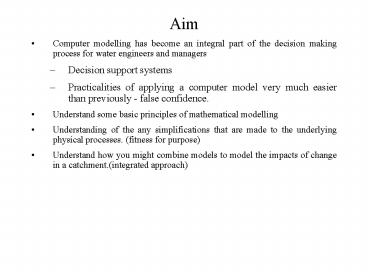Flood Routing - PowerPoint PPT Presentation
1 / 33
Title:
Flood Routing
Description:
Local. acceleration. term. Convective. acceleration. term ... Weather radar stations. 0. 2. 4. 8. 12. 30. 45. 60. Large Scale Modelling. The research problems ... – PowerPoint PPT presentation
Number of Views:89
Avg rating:3.0/5.0
Title: Flood Routing
1
Aim
- Computer modelling has become an integral part of
the decision making process for water engineers
and managers - Decision support systems
- Practicalities of applying a computer model very
much easier than previously - false confidence. - Understand some basic principles of mathematical
modelling - Understanding of the any simplifications that are
made to the underlying physical processes.
(fitness for purpose) - Understand how you might combine models to model
the impacts of change in a catchment.(integrated
approach)
2
(No Transcript)
3
Approaches
- Depend on the problem
- We are interested in flows only
- Not particularly concerned about water levels
- Distributed flow routing
- Prof. Penders course
- aimed at obtaining details of water levels
- physics based but dependent on the channel type
- HEC-RAS steady flows based on conservation of
energy - St-Venant for un-steady
- solve using a finite difference equation
- Lumped routing
- simplification of the physics
- reduced set of parameters
4
Flow Routing
- Physics
- Conservation of mass
- Conservation of momentum (Newtons Second Law)
5
Pressure force term
Local acceleration term
Convective acceleration term
Gravity force term
Friction force term
6
Propagation of disturbance
7
I-Q
Swedge Storage in reach associate with wedge set
up by flow I- Q
Q
SQ Storage in reach associate with flow Q
Q
8
(No Transcript)
9
Large Scale Hydrological Modelling
Cloud Physics Mass and Energy Fluxes
Hydrology
10
(No Transcript)
11
(No Transcript)
12
(No Transcript)
13
(No Transcript)
14
(No Transcript)
15
(No Transcript)
16
(No Transcript)
17
Each Cell ? 350km2
18
River Network
- St Venant Equations (conservation of mass and
momentum) - For most routing problems these can be
approximated by
19
(No Transcript)
20
Simulating Runoff from a grid cell
21
Terrain map for a typical cell
Spatial heterogeneity in runoff is enormous
Can you capture some of the heterogeneity without
sub-dividing the domain ?
22
Groundwater Discharge aSb Where a and b are
constants that are related to the average
conductivity and hillslope length
23
2000 cells simulating runoff, soil moisture,
evaporation etc. The runoff routed using the
channel routing model.
24
Weather radar stations
25
(No Transcript)
26
(No Transcript)
27
(No Transcript)
28
(No Transcript)
29
(No Transcript)
30
(No Transcript)
31
(No Transcript)
32
(No Transcript)
33
Large Scale Modelling
- The research problems
- Scale
- Computational Efficiency
- Parameterisation































